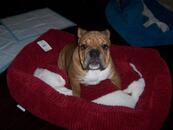You are using an out of date browser. It may not display this or other websites correctly.
You should upgrade or use an alternative browser.
You should upgrade or use an alternative browser.
Rectal stricture
- Thread starter bigrod48
- Start date
- Mar 21, 2011
- 13,407
- 848
- Country
- USA
- Bulldog(s) Names
- BeBe, Hazel, Lucy Lu, JLO, Hillary, Henri, & Katie
Someone on here had a bully with this, but I can't remember who it was. Maybe someone with a good memory will be along and let us know. Sorry I'm no help.
JAKEISGREAT
.................
[MENTION=2]desertskybulldogs[/MENTION]. [MENTION=1714]Sherry[/MENTION]...
- Jan 28, 2010
- 24,756
- 1,252
- Country
- USA
- Bulldog(s) Names
- The Home of the Desert Sky Pack
I cannot remember either, perhaps I'll check search to find out.
Sent from my iPhone 5 using Tapatalk
Sent from my iPhone 5 using Tapatalk

Sherry
New member
- Jan 15, 2011
- 5,183
- 477
- Country
- USA
- Bulldog(s) Names
- Jack , Dolly, Grizz, Peggy Sue, and Scrimps
I coppied this for you, I hope it will help
Rectal or anal strictures cause narrowing of the lumen due to scar tissue that forms as a result of rectal inflammation, rectal trauma (from injury or surgery), or proliferative neoplastic disease in the rectum. The clinical picture (e. g., constipation, dyschezia, and, ultimately, vomiting or anorexia) is indistinguishable from that presented by extraluminal narrowing of the colon due to neoplasia, prostatic disease, or pelvic fracture.
[h=3]History and Physical Examination[/h]The typical history is an older dog that has chronic constipation or progressively more difficulty defecating. Affected dogs have persistent tenesmus, prolonged posturing to defecate, and frequent attempts to defecate, with on. y a narrow ribbon of feces or no feces produced. If concurrent colorectal inflammatory or neoplastic disease is present, hematochezia, mucoid feces, or diarrhea may be observed. As the duration and severity of the obstruction worsen, other systemic signs may be observed (e. g., lethargy, anorexia, vomiting, weight loss). Several conditions can predispose dogs to the development of a rectal stricture, including recent rectal or anal surgery, chronic rectal or anal inflammation, rectal neoplasia, and ingestion of foreign material that causes rectal trauma as it is passed.
Digital rectal examination is sufficient to identify a narrow and often very tight rectal or anal opening. Benign strictures are firm, thick, annular fibrotic bands that must be differentiated from neoplastic strictures, which tend to be asymmetric, masslike formations. However, annular rectal adenocarcinoma cannot be distinguished from a benign fibrotic stricture by palpation alone. The only other physical abnormality found in dogs with rectal stricture is an enlarged colon with hard or impacted feces.
[h=3]Diagnosis[/h]In most dogs, the history and physical examination are sufficient to identify a stricture. The key aspect of diagnosis is determining whether the stricture is malignant or benign. Radiographs and ultrasound scans of the abdomen and pelvis are important, because they rule out other causes of constipation / obstipation, such as pelvic fractures, prostatomegaly, and abdominal masses that affect the colon or sublumbar lym-phadenopathy. Contrast radiography is not usually necessary to make a diagnosis of stricture, but it may be helpful for determining the extent of the stricture if the opening is too narrow for physical analysis. Rectal probe ultrasonography can be used to determine the extent of rectal involvement or to detect other lesions. Ultimately, however, biopsy is necessary to determine whether the lesion is benign or malignant. Biopsy of tissue can be obtained through rigid proctoscopy, flexible endoscopy, or direct visualization by prolapse of the affected rectal tissues. A major limitation on the use of either a rigid or a flexible scope to obtain biopsy specimens is that passage of the scope and distention of the rectum (for visualization) often is impossible. In such cases, direct prolapse or surgical biopsies must be obtained.
[h=3]Therapy[/h]Previously, rectal strictures were managed by surgical techniques, such as rectal pull-through or rectal myotomy procedures. More recently, bougienage and balloon dilatation techniques have gained favor, because when performed properly, they are often successful in dilating the stricture site without incurring the severe complications that frequently accompany surgical correction (e. g., fecal incontinence, infection, dehiscence, or restricture). To facilitate appropriate visualization and comfort for these procedures, the dog or cat should be anesthetized, and if possible the procedure should be done with endoscopic or fluoroscopic assistance.
For bougienage of rectal strictures, a metal bougie of increasing size (over several separate but successive procedures) is passed into the stricture site and advanced slowly, stretching the fibrous tissue without causing significant tearing, which tends to increase inflammation and the likelihood of restricture.
Like esophageal strictures, rectal strictures also can be successfully dilated using balloon dilatation techniques, and this approach is frequently preferred over bougienage. The diameter of the balloon and the number of dilatations required to achieve a sustained opening in the rectal lumen are quite variable, but chronic strictures in larger animals may require several procedures to achieve functional success. In general, for small dogs (less than 7 kg) and cats, balloons with a diameter of 10 to 15 mm are used; for medium-sized dogs, the balloon diameter is 20 to 30 mm; and for large dogs (greater than 16 kg), it is 30 to 40 mm. These numbers are guidelines, because animals with severe rectal strictures may require much smaller balloons for the initial procedure to prevent excessive tissue tearing. In dogs with recent strictures or those without excessive fibrosis, one or two dilatation procedures 4 to 5 days apart may be all that is required to dilate the affected tissue successfully. However, when rectal wall thickening is present or the reduction in the lumen is greater than 75%, four to six dilatation procedures may be required to achieve functional success. The purpose of performing multiple procedures several days apart (but no more than 7 days) is to increase the diameter of the stricture waist gradually, without excessive tearing or inflammation; this gradual approach reduces the likelihood of restricture (which tends to occur in 7 to 10 days). Careful visualization of the procedure ensures that tearing and hemorrhage are kept to a minimum and reduces the risk of deep tears or significant hemorrhage, which increase the likelihood of restricture or rectal perforation. Adjunct therapy should include administration of broad-spectrum antibiotics, a highly digestible (low-residue) diet, and use of lactulose or stool softeners to maintain a soft fecal consistency. The use of corticosteroids to reduce the occurrence of restricture has not been studied, and such therapy should be undertaken cautiously if rectal tears or bacterial contamination is suspected.
[h=3]Prognosis[/h]For most benign rectal strictures, the prognosis is guarded to fair, because balloon procedures may allow return to near normal functionality; however, unless the predisposing cause of the stricture is corrected, it is likely to recur. The risk of severe complications after balloon procedures is lower than for surgical repair techniques, primarily because the risk of inducing fecal incontinence is greatly diminished. The prognosis for all neoplastic strictures is poor, owing both to the difficulty in managing the primary problem and to the poor response to balloon or other management techniques.
Rectal or anal strictures cause narrowing of the lumen due to scar tissue that forms as a result of rectal inflammation, rectal trauma (from injury or surgery), or proliferative neoplastic disease in the rectum. The clinical picture (e. g., constipation, dyschezia, and, ultimately, vomiting or anorexia) is indistinguishable from that presented by extraluminal narrowing of the colon due to neoplasia, prostatic disease, or pelvic fracture.
[h=3]History and Physical Examination[/h]The typical history is an older dog that has chronic constipation or progressively more difficulty defecating. Affected dogs have persistent tenesmus, prolonged posturing to defecate, and frequent attempts to defecate, with on. y a narrow ribbon of feces or no feces produced. If concurrent colorectal inflammatory or neoplastic disease is present, hematochezia, mucoid feces, or diarrhea may be observed. As the duration and severity of the obstruction worsen, other systemic signs may be observed (e. g., lethargy, anorexia, vomiting, weight loss). Several conditions can predispose dogs to the development of a rectal stricture, including recent rectal or anal surgery, chronic rectal or anal inflammation, rectal neoplasia, and ingestion of foreign material that causes rectal trauma as it is passed.
Digital rectal examination is sufficient to identify a narrow and often very tight rectal or anal opening. Benign strictures are firm, thick, annular fibrotic bands that must be differentiated from neoplastic strictures, which tend to be asymmetric, masslike formations. However, annular rectal adenocarcinoma cannot be distinguished from a benign fibrotic stricture by palpation alone. The only other physical abnormality found in dogs with rectal stricture is an enlarged colon with hard or impacted feces.
[h=3]Diagnosis[/h]In most dogs, the history and physical examination are sufficient to identify a stricture. The key aspect of diagnosis is determining whether the stricture is malignant or benign. Radiographs and ultrasound scans of the abdomen and pelvis are important, because they rule out other causes of constipation / obstipation, such as pelvic fractures, prostatomegaly, and abdominal masses that affect the colon or sublumbar lym-phadenopathy. Contrast radiography is not usually necessary to make a diagnosis of stricture, but it may be helpful for determining the extent of the stricture if the opening is too narrow for physical analysis. Rectal probe ultrasonography can be used to determine the extent of rectal involvement or to detect other lesions. Ultimately, however, biopsy is necessary to determine whether the lesion is benign or malignant. Biopsy of tissue can be obtained through rigid proctoscopy, flexible endoscopy, or direct visualization by prolapse of the affected rectal tissues. A major limitation on the use of either a rigid or a flexible scope to obtain biopsy specimens is that passage of the scope and distention of the rectum (for visualization) often is impossible. In such cases, direct prolapse or surgical biopsies must be obtained.
[h=3]Therapy[/h]Previously, rectal strictures were managed by surgical techniques, such as rectal pull-through or rectal myotomy procedures. More recently, bougienage and balloon dilatation techniques have gained favor, because when performed properly, they are often successful in dilating the stricture site without incurring the severe complications that frequently accompany surgical correction (e. g., fecal incontinence, infection, dehiscence, or restricture). To facilitate appropriate visualization and comfort for these procedures, the dog or cat should be anesthetized, and if possible the procedure should be done with endoscopic or fluoroscopic assistance.
For bougienage of rectal strictures, a metal bougie of increasing size (over several separate but successive procedures) is passed into the stricture site and advanced slowly, stretching the fibrous tissue without causing significant tearing, which tends to increase inflammation and the likelihood of restricture.
Like esophageal strictures, rectal strictures also can be successfully dilated using balloon dilatation techniques, and this approach is frequently preferred over bougienage. The diameter of the balloon and the number of dilatations required to achieve a sustained opening in the rectal lumen are quite variable, but chronic strictures in larger animals may require several procedures to achieve functional success. In general, for small dogs (less than 7 kg) and cats, balloons with a diameter of 10 to 15 mm are used; for medium-sized dogs, the balloon diameter is 20 to 30 mm; and for large dogs (greater than 16 kg), it is 30 to 40 mm. These numbers are guidelines, because animals with severe rectal strictures may require much smaller balloons for the initial procedure to prevent excessive tissue tearing. In dogs with recent strictures or those without excessive fibrosis, one or two dilatation procedures 4 to 5 days apart may be all that is required to dilate the affected tissue successfully. However, when rectal wall thickening is present or the reduction in the lumen is greater than 75%, four to six dilatation procedures may be required to achieve functional success. The purpose of performing multiple procedures several days apart (but no more than 7 days) is to increase the diameter of the stricture waist gradually, without excessive tearing or inflammation; this gradual approach reduces the likelihood of restricture (which tends to occur in 7 to 10 days). Careful visualization of the procedure ensures that tearing and hemorrhage are kept to a minimum and reduces the risk of deep tears or significant hemorrhage, which increase the likelihood of restricture or rectal perforation. Adjunct therapy should include administration of broad-spectrum antibiotics, a highly digestible (low-residue) diet, and use of lactulose or stool softeners to maintain a soft fecal consistency. The use of corticosteroids to reduce the occurrence of restricture has not been studied, and such therapy should be undertaken cautiously if rectal tears or bacterial contamination is suspected.
[h=3]Prognosis[/h]For most benign rectal strictures, the prognosis is guarded to fair, because balloon procedures may allow return to near normal functionality; however, unless the predisposing cause of the stricture is corrected, it is likely to recur. The risk of severe complications after balloon procedures is lower than for surgical repair techniques, primarily because the risk of inducing fecal incontinence is greatly diminished. The prognosis for all neoplastic strictures is poor, owing both to the difficulty in managing the primary problem and to the poor response to balloon or other management techniques.
Similar threads
- Replies
- 2
- Views
- 409
- Replies
- 5
- Views
- 950
- Replies
- 4
- Views
- 810




